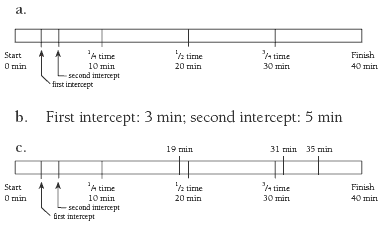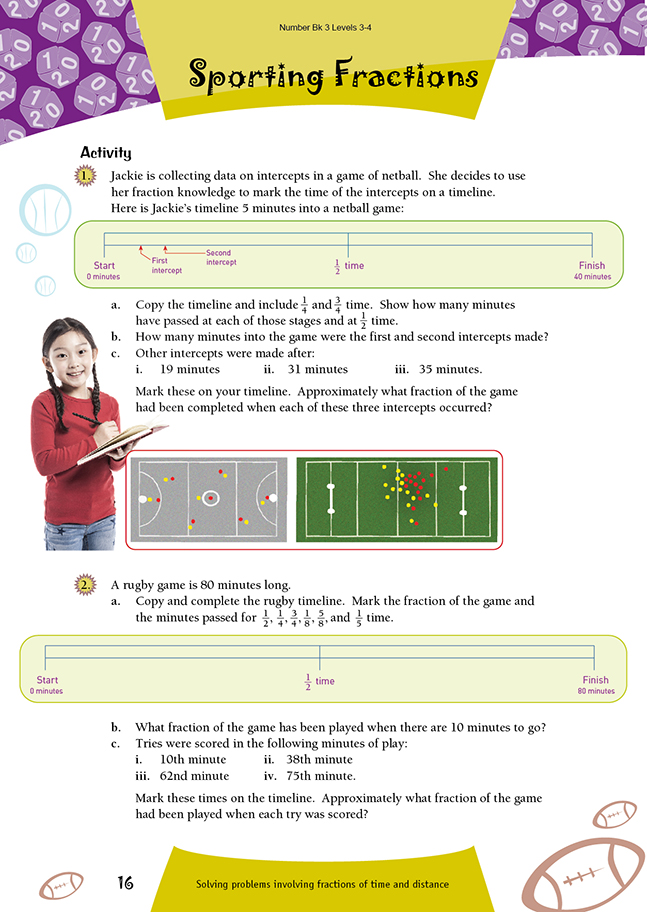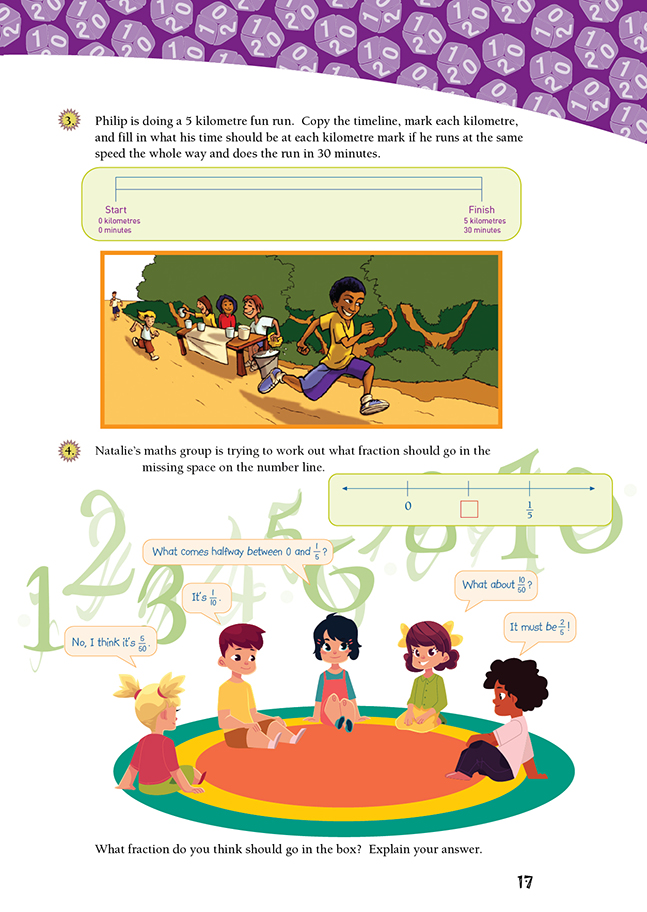This is a level 4 number activity from the Figure It Out series. It relates to Stage 7 of the Number Framework.
A PDF of the student activity is included.
Click on the image to enlarge it. Click again to close. Download PDF (390 KB)
order fractions
mark a fraction on a length
FIO, Level 3-4, Number, Book 3, Sporting Fractions, pages 16-17
This activity involves the proportional concepts of fraction and rate. It is suitable for students at the advanced additive stage or beyond of the Number Framework.
Sporting commentaries (on radio and television) that include reference to various game statistics are fairly commonplace these days. This activity investigates statistics related to netball, rugby, and distance running and uses estimation involving fractions.
In questions 1a and 1b, the times of the first and second intercepts can be estimated fairly easily once the 1/4 or 10 minute mark is inserted into the timeline. The second intercept appears to be halfway between the start and the 10 minute mark, so it is likely that it occurred at 5 minutes.
Once the students have established this, they will see that the first intercept occurred at about the 3 minute mark. The students should use the 1/4, 1/2, and 3/4 marks as benchmarks to solve the other problems.
With the 3/4 or 30 minute mark placed on the timeline midway between half-time and the finish, the 3 times in question 1c can now be marked on. The 19 minute intercept will be marked just before half-time, the 31 minute intercept just after 3/4 time, and the 35 minute intercept midway between the 3/4 time and the end of the game. Midway between 3/4 time and the game’s end, in fact, is the 7/8 time mark. If the students are unsure of this, encourage them to draw up a fraction wall, for example:
An activity involving a fraction wall can be found in Fraction Frenzy, Number: Book Three, Figure It Out, Level 3.
When a fraction is halved, the students may think that the halved fraction is bigger, when it is actually the opposite. For example, 1/2 x 1/5 = 1/10. You could show them this on a number line.
The fraction wall or the Cuisenaire™ rods activity suggested below for question 4 will also help the students with question 2a, in which the fractions can be progressively marked on the timeline, beginning with the halfway or 40 minute mark. This can be followed by inserting the 1/4 or 20 minute mark midway between the start and half-time and the 3/4 or 60 minute mark midway
between half-time and the finish. Now the 1/8 (10 minute) and 5/8 (50 minute) marks can be inserted midway between the start and 1/4 time and the half-time and 3/4 time respectively. The 1/5 or 16 minute mark presents a slightly greater challenge, but it can be located just over midway between the 1/8 (10 minute) and 1/4 (20 minute) marks.
Having established that 10 minutes represents 1/8, the students should not find it too hard to work out in question 2b that, with 10 minutes to go, there is 1/8 of the game remaining, which means that 7/8 of the game has been played.
In question 2c, the students should see at a glance that the try scored in the 10th minute occurred when 1/8 of the game had been played. The try scored in the 38th minute would have occurred when just less than half the game had been played because the 40th minute was the halfway point.
The try scored in the 62nd minute, on the other hand, would have occurred when just over 3/4 of the game had been played (since the 60th minute was the 3/4 point). Finally, the try scored in the 75th minute occurred midway between the 7/8 point and full-time, so that must have been when 15/16 of the game had been played. If, however, the students look at their timeline and estimate that this was after approximately 9/10 of the game has been played, this is an acceptable alternative.
In question 3, if Philip runs consistently and covers 5 kilometres in 30 minutes, this means that he takes 6 minutes to run each kilometre. Consequently, the timeline for his run will be divided into fifths, with the marks indicating 1 kilometre (6 minutes), 2 kilometres (12 minutes), 3 kilometres (18 minutes), 4 kilometres (24 minutes), and 5 kilometres (30 minutes).
Question 4 is similar to the task in question 2 of working out the midway point between 7/8 and 1. In this case, the students may be able to work out that the clue to solving the problem is to convert the 1/5 into smaller fractions. Their earlier work with decimals may suggest to them that fifths can be changed into tenths without too much difficulty. This can actually be done very effectively in a hands-on fashion with Cuisenaire™ rods (which are really a solid number line). Let the orange rod represent 1. Then the red rods represent fifths (because 5 of them fit exactly along 1 orange rod) and the white rods represent tenths (because 10 of them fit exactly along 1 orange rod). The students can then observe that there are 2 tenths for every fifth. From this, they should be able to work out that halfway between 0 and 1/5 on the number line is 1/10.
Answers to Activity
1. a

Fractions of the game completed:
i. just less than 1/2
ii. just over 3/4
iii. 7/8, midway between 3/4 and the finish
2. a.
b. 7/8
c.
Fractions should be close to:
i. 1/8
ii. 1/2
iii. 3/4
iv. Either 15/16 or 9/10
3.
(You could also show this as a double number line.)
4. 5/50 or 1/10. This is 1/2 of 1/5. Another explanation is: 1/5 is 2/10. Half of 2/10 is 1/10.





